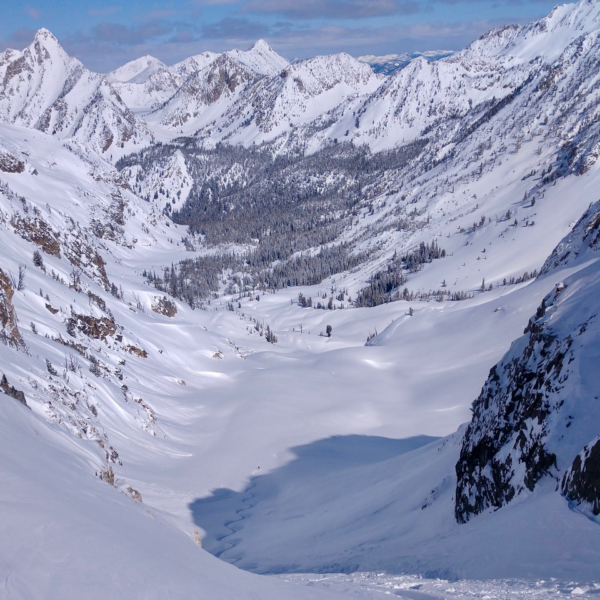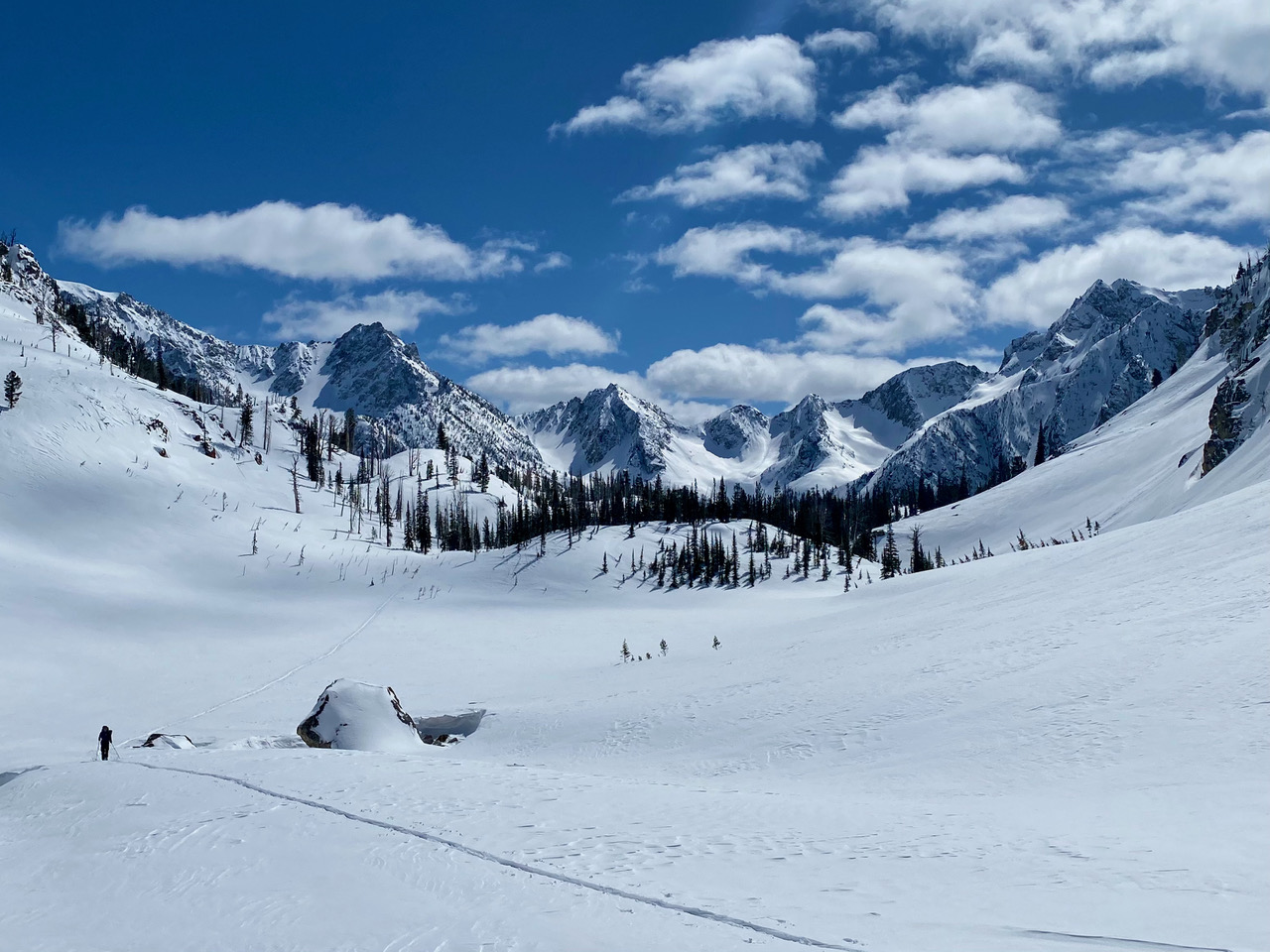Words by AMGA/IFMGA Mountain Guide & Salomon Freeski Ambassador Drew Daly
I have been dreaming about doing a ski traverse across Idaho’s Sawtooth Mountains for well over a decade. The majority of my adult life has been spent working and playing in this iconic mountain range. I’ve done a lot of skiing in the Sawtooths, but it always felt like I was on the outskirts, looking into a vast unknown. In the summer, I guide clients up the jagged spires and shear walls of the Sawtooths. It’s during these summer adventures, camping at some of the 400 alpine lakes, that I dream of what it would be like to experience the remote drainages in winter.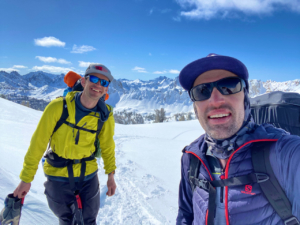
It’s no secret that the Sawtooths offer incredible ski mountaineering. Two of the 50 Classic Ski Descents in North America are in the Sawtooths. There are a handful of huts and yurts built specifically for accessing some of the amazing terrain. Despite this, much of the range is very difficult to access in the winter. All of the roads off of the highway close, the lakes freeze over, and the Wilderness boundary limits motorized access. For this reason, winter camping becomes a necessity to ski in the more remote drainages of the Sawtooths.
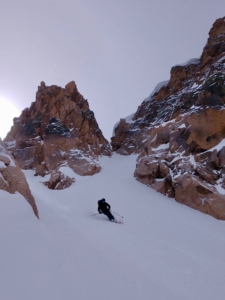 In March of 2021 the stars aligned. After a winter of incredibly poor avalanche stability and record setting avalanche deaths across the United States, the snowpack had finally settled. Additionally, this was the first spring in six years that I wasn’t traveling internationally for work (a silver lining of the COVID-19 pandemic). Most importantly I had a psyched partner, fellow guide, Matt Scrivner.
In March of 2021 the stars aligned. After a winter of incredibly poor avalanche stability and record setting avalanche deaths across the United States, the snowpack had finally settled. Additionally, this was the first spring in six years that I wasn’t traveling internationally for work (a silver lining of the COVID-19 pandemic). Most importantly I had a psyched partner, fellow guide, Matt Scrivner.
It didn’t take us long to plan our route. We have had countless outings together both skiing and climbing in the Sawtooths, many of them talking about what a traverse of the range might look like. Also, with a collective 25 years of guiding experience in the Sawtooths we’ve become intimately familiar with many of the drainiages. We decided on a south to north route that would take four days and three nights. This would give us enough time to cover the heart of the range and ski some iconic lines without overloading our packs with a week’s worth of food or complicating the logistics with a remote cache.
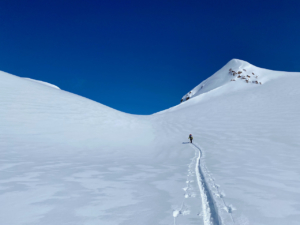 Our adventure started on a frigid morning with a tandem snowmobile ride to the Wilderness boundary at Alturas Lake Creek. We slapped skins on our skis and began a long trek into the remote Wilderness with excitement and a haze of nervousness. Our goal was to have light enough packs to travel efficiently and feel comfortable skiing steep terrain while still having enough gear to keep the suffering of winter camping to a minimum. Despite this, it wasn’t long before our “alpine style” packs began to slow us down and make us thankful we had left the whiskey in the car. It was early afternoon when we gained treeline and made it to our first big saddle where we could finally see deep into the Sawtooths and remember why we were there.
Our adventure started on a frigid morning with a tandem snowmobile ride to the Wilderness boundary at Alturas Lake Creek. We slapped skins on our skis and began a long trek into the remote Wilderness with excitement and a haze of nervousness. Our goal was to have light enough packs to travel efficiently and feel comfortable skiing steep terrain while still having enough gear to keep the suffering of winter camping to a minimum. Despite this, it wasn’t long before our “alpine style” packs began to slow us down and make us thankful we had left the whiskey in the car. It was early afternoon when we gained treeline and made it to our first big saddle where we could finally see deep into the Sawtooths and remember why we were there.
The next four days were filled with some of the most spectacular ski touring of my life. Every big climb was rewarded with an incredible descent. Every new high point revealed another vast realm of ski terrain. Every time we ticked a descent off the list, we saw another three lines we wanted to come back and ski. A phantom spring storm on day three served up some of the best powder skiing of the season. Exploring this terrain in winter was truly a dream come true.
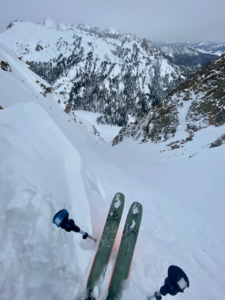
The nights were far less dreamy, but snow camping is half of the fun during an adventure like this. At least that’s what we told ourselves, hoping the optimism would keep suffering to a minimum. Every evening we spent about an hour setting up and digging out our shelter. Temperatures in the teens paired with condensation on our single wall shelter made for cold and damp sleeping conditions. The white gas stove (as opposed to a canister stove) was key for melting snow and boiling water, and puffy pants are worth their weight in gold!
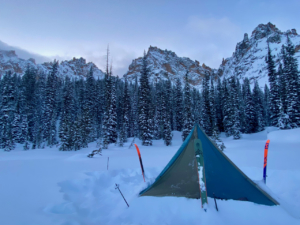
Like any true adventure in the mountains, it didn’t go perfectly as planned. One of our intended ski descents had been completely scoured by wind requiring us to downclimb rocks for a couple hundred feet. A slight chance of precipitation turned into a foot of new snow resulting in us triggering a small avalanche and choosing to change our route into less hazardous terrain. Our down sleeping bags might as well have been cotton towels by night three. It’s these experiences that define adventures.
The final day of the traverse dawned blue bird and our route brought us through some of the most spectacular ski terrain in the range. As we exited themountains at Iron Creek Trailhead, we were completely out of food and fuel, but we were so full of inspiration and gratitude. We hadn’t embarked on this trip to set records or ski first descents, but rather to experience a different perspective of a familiar mountain range. During a year that has been so tragic for humanity, it’s a privilege to explore the mountains in our backyard and come home feeling inspired and rejuvenated.
